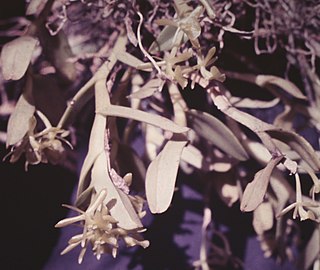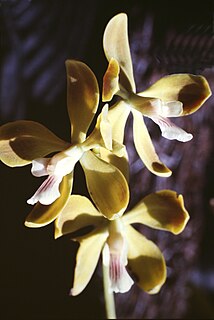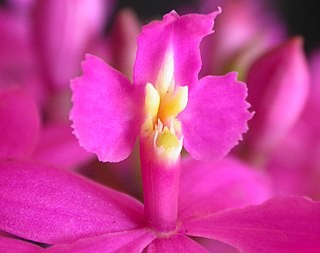This page is based on this
Wikipedia article Text is available under the
CC BY-SA 4.0 license; additional terms may apply.
Images, videos and audio are available under their respective licenses.

Laeliinae is a Neotropical subtribe including 40 orchid genera, such as Brassavola, Laelia and Cattleya. The genus Epidendrum is the largest within this subtribe, containing about 1500 species. This is followed by the genus Encyclia, with over 120 species.

Coilostylis falcata, formerly Epidendrum falcatum, is an orchid in the genus Coilostylis, a genus recently resurrected and split from Epidendrum.

Coilostylis ciliaris, formerly Epidendrum ciliare, is a species of orchid in the genus Coilostylis. It was transferred from Epidendrum by Withner and Harding in 2004. It is the type species of the genus Coilostylis.

Epidendrum compressum is a species of orchid in the genus Epidendrum from wet montane forests of Trinidad, Venezuela, Colombia, Ecuador, Peru and Bolivia.

Epidendrum difforme is a species of orchid in the genus Epidendrum. In 1861, Müller classified this species in the subsection Umbellata of the section Planifolia of subgenus Euepidendrum Lindl. of the genus Epidendrum.

Epidendrum magnoliae, sometimes called Epidendrum conopseum or the green-fly orchid, is a species of orchid in the genus Epidendrum. It is the most northern-growing epiphytic orchid in North America, being found wild in the southeastern United States from Louisiana to North Carolina, and also in northeastern Mexico.

Epidendrum microphyllum is a species of tropical orchid in the genus Epidendrum with non-resupinate flowers.

Epidendrum peperomia, the peperomia-like epidendrum, is a species of orchid in the genus Epidendrum.

Epidendrum polyanthum is a species of orchid in the genus Epidendrum.

Encyclia diurna is a species of orchid.

Epidendrum ibaguense is a species of epiphytic orchid of the genus Epidendrum which occurs in Trinidad, French Guyana, Venezuela, Colombia and Northern Brazil.
The section Epidendrum sect. Planifolia of the subgenus E. subg. Epidendrum Lindl. 1841 of the genus Epidendrum of the Orchidaceae was published in 1861 by Reichenbach It differs from the other three sections by having flat leaves. Like the other sections of E. subg. Epidendrum, the inflorescence grows from the apex of the stem, and bears no spathe or sheath at the base of the peduncle.

Epidendrum sect. Schistochila Rchb.f. (1861) is a section of the subgenus E. subg. Amphiglottium Lindl. (1841) of the Genus Epidendrum of the Orchidaceae. E. sect. Schistochila differs from the section E. sect. Holochila in that the species in E. sect. Holochila have undivided lips; the species in E. sect. Schistochila have lobate lips. The species in both E. sect. Schistochila and E. sect. Holochila have racemose inflorescences, unlike those in E. sect. Polycladia, which have truly paniculate inflorescences. Like the other sections of E. subg. Amphiglottium, the members of E. sect. Schistochila are sympodial orchids bearing thin stems with alternate leaves, a long peduncle covered with thin, imbricating sheathes, and a lip adnate to the very end of the column.

The subgenus Epidendrum subg. Epidendrum was published as "Euepidendrum" in 1841 with the diagnosis "Caulis foliosus. Pedunculus brevis esquamatus. Labellum adnatum." This reed-stemmed genus includes sympodial Epidendrum plants with stems covered with imbricating sheaths which show no tendency to swell into pseudobulbs, and with terminal inflorescences which lack any sheath or spathe at the base.

The section Epidendrum sect. Sarcophylla Rchb.f. is a subsection of subgenus E. subg. Epidendrum of the genus Epidendrum of the Orchidaceae. In 1861, Reichenbach recognized one species in this section:

Epidendrum subg. Amphiglottium (Salisb.) Lindl. 1841 is a subgenus of reed-stemmed Epidendrums, distinguished by an apical inflorescence with the peduncle covered from its base with close imbricating sheaths and by a lip that is adnate to the column to its apex.















